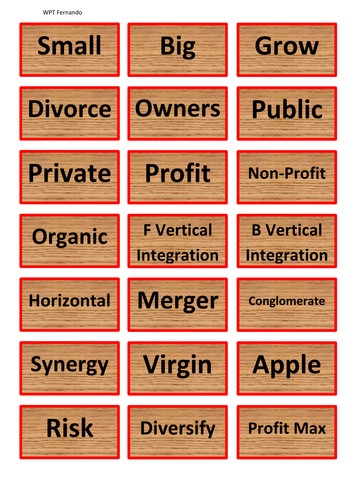

TI created this game as a fun revision exercise for Unit 3 Economics. It was inspired by the game Codenames.
150 terms have been selected from the specification to ensure students are able to understand how it links to other terms in the syllabus.
Quinns Smith’s instruction to play the actual board game is a good way of describing how to play this.
Here’s how it works. You deal out a grid of 25 words, divide your players into two teams, and each team nominates a team leader.
The team leaders are then given access to a card that designates each word on the grid as an agent belonging to the red or blue team, a boring, beige-coloured innocent bystander, or the DEADLY ASSASSIN WORD (black card).
How you go about this is equally simple. Each turn, the team leader says a single word (that can’t be on the board) followed by a number, for example, “Desert 2”. What you’re saying there is that two of your team’s words on this grid relate to deserts.
The other players on your team then play a kind of verbal minesweeper, discussing the clue in a way that will invariably see the team leader wanting to bang their head on the table. “Palm trees are in the desert! Aren’t they? Oh! You need bottles in a desert! Or, um…” Eventually, they’ll point to a word and wince.
The team leader then covers this up with the word’s corresponding tile, hopefully an agent of your colour. What you don’t want is for it to be an innocent bystander, because then you have to stop guessing and pass your turn over to the other team (not forgetting the clue you failed to get which is, of course, still on the board). What you REALLY don’t want is for it to be an enemy agent, as you give them a point and still have to stop guessing. But what you really, really, really don’t want is for it to be the assassin word, because then you instantly lose the game.
ASSEMBLY REQUIRED!!
150 terms have been selected from the specification to ensure students are able to understand how it links to other terms in the syllabus.
Quinns Smith’s instruction to play the actual board game is a good way of describing how to play this.
Here’s how it works. You deal out a grid of 25 words, divide your players into two teams, and each team nominates a team leader.
The team leaders are then given access to a card that designates each word on the grid as an agent belonging to the red or blue team, a boring, beige-coloured innocent bystander, or the DEADLY ASSASSIN WORD (black card).
How you go about this is equally simple. Each turn, the team leader says a single word (that can’t be on the board) followed by a number, for example, “Desert 2”. What you’re saying there is that two of your team’s words on this grid relate to deserts.
The other players on your team then play a kind of verbal minesweeper, discussing the clue in a way that will invariably see the team leader wanting to bang their head on the table. “Palm trees are in the desert! Aren’t they? Oh! You need bottles in a desert! Or, um…” Eventually, they’ll point to a word and wince.
The team leader then covers this up with the word’s corresponding tile, hopefully an agent of your colour. What you don’t want is for it to be an innocent bystander, because then you have to stop guessing and pass your turn over to the other team (not forgetting the clue you failed to get which is, of course, still on the board). What you REALLY don’t want is for it to be an enemy agent, as you give them a point and still have to stop guessing. But what you really, really, really don’t want is for it to be the assassin word, because then you instantly lose the game.
ASSEMBLY REQUIRED!!
Something went wrong, please try again later.
This resource hasn't been reviewed yet
To ensure quality for our reviews, only customers who have purchased this resource can review it
Report this resourceto let us know if it violates our terms and conditions.
Our customer service team will review your report and will be in touch.
£2.00
